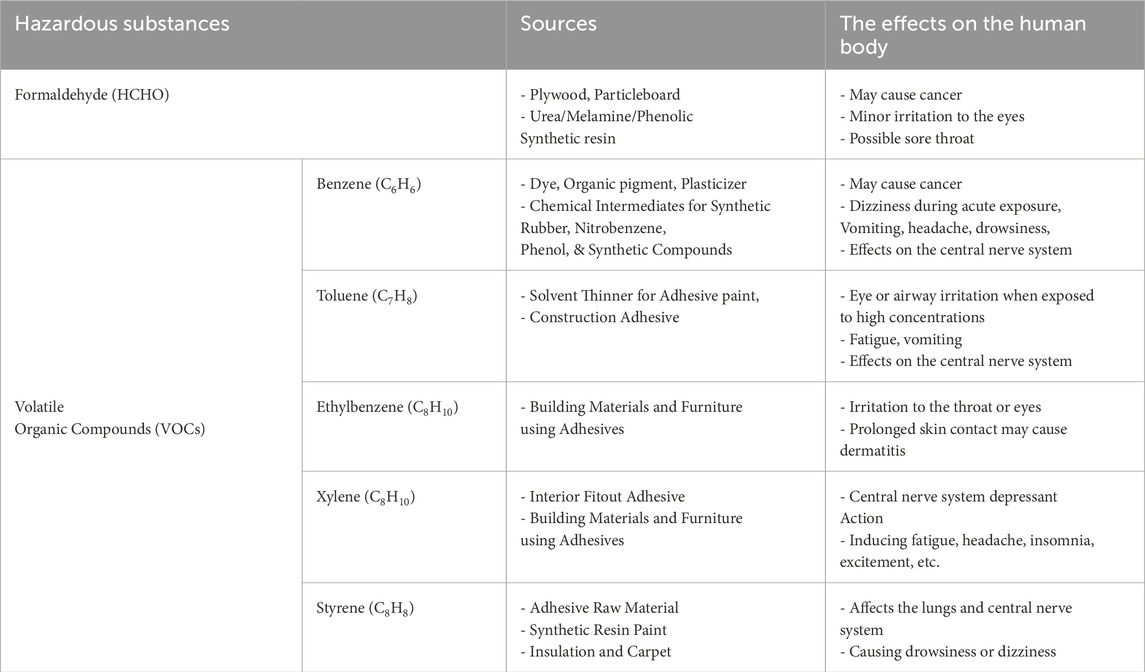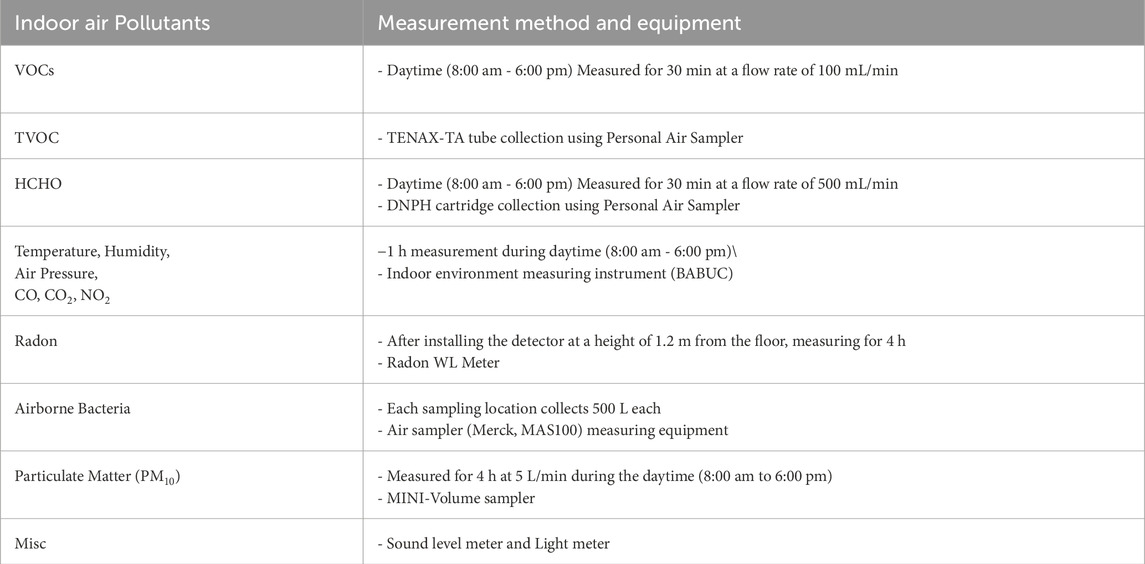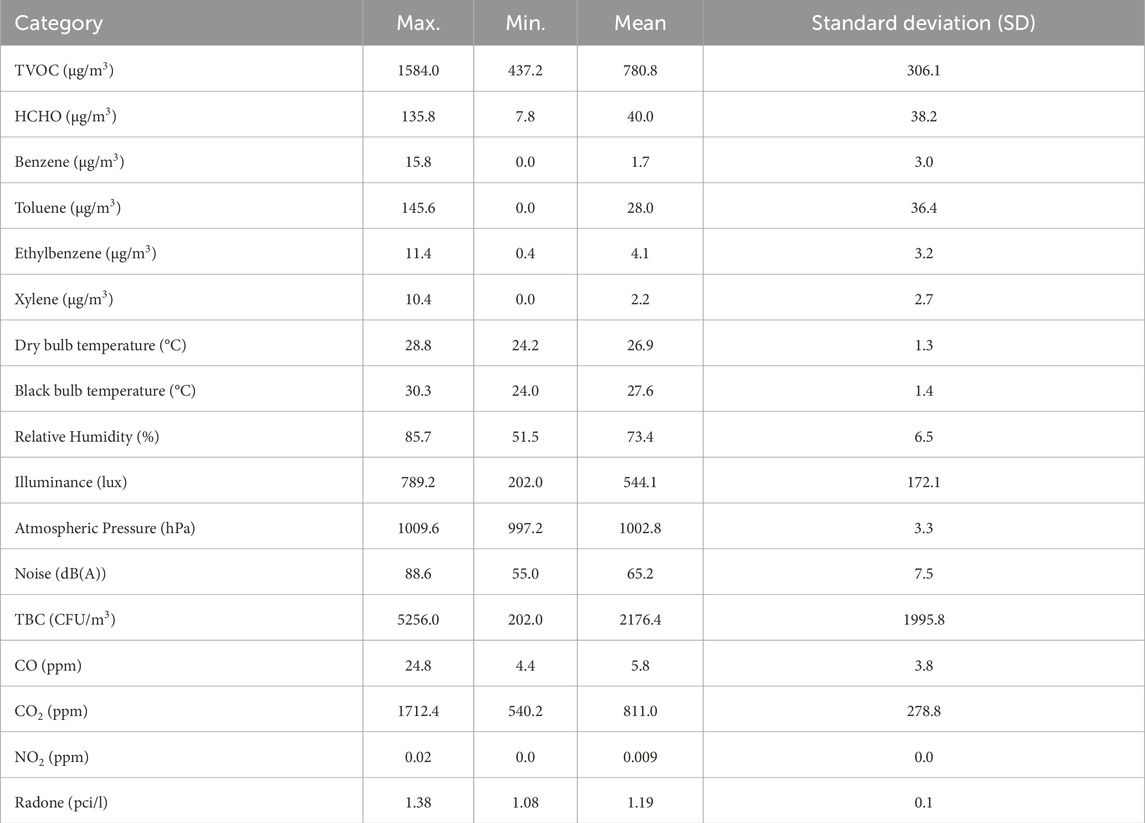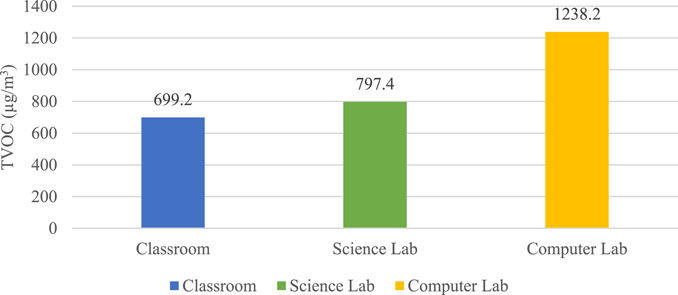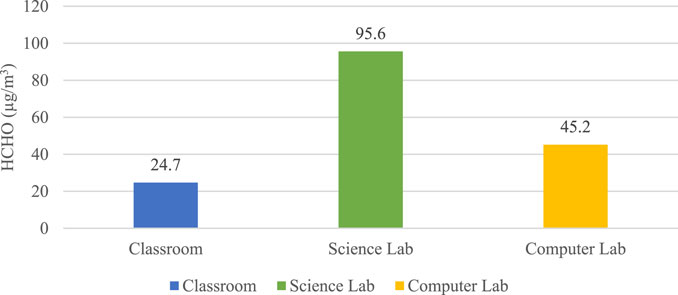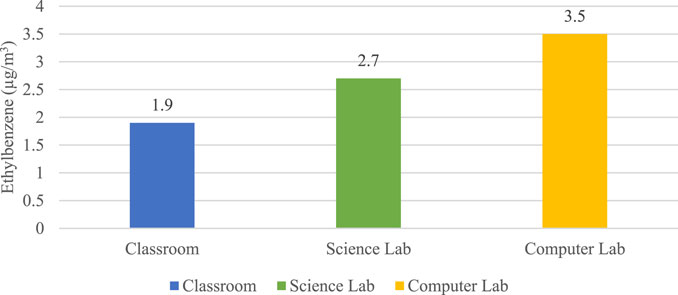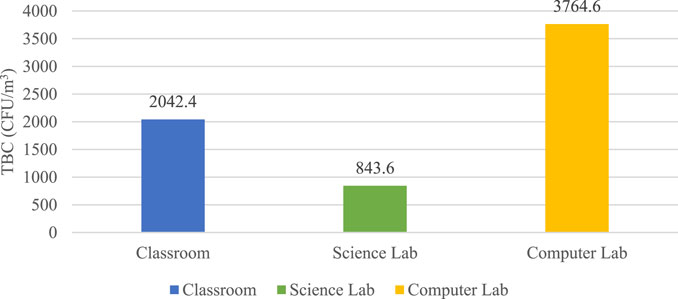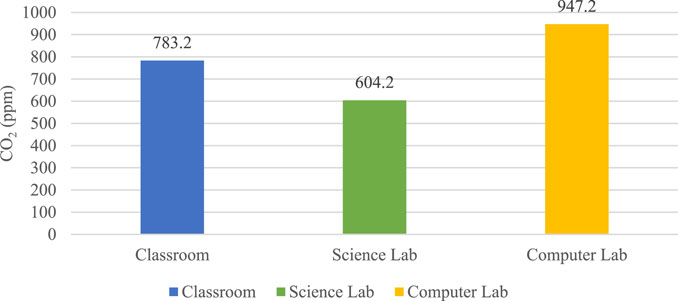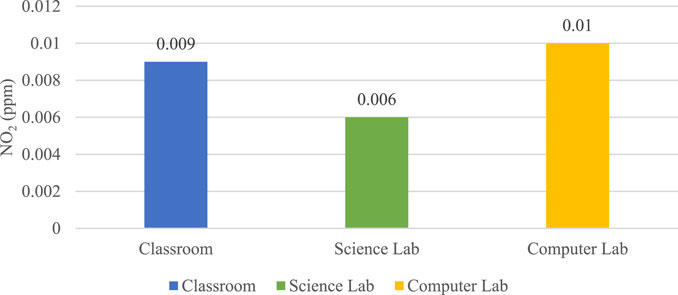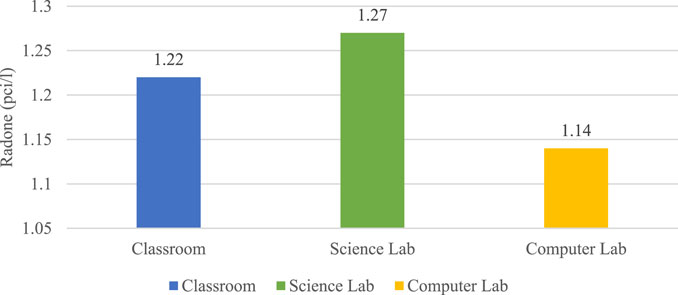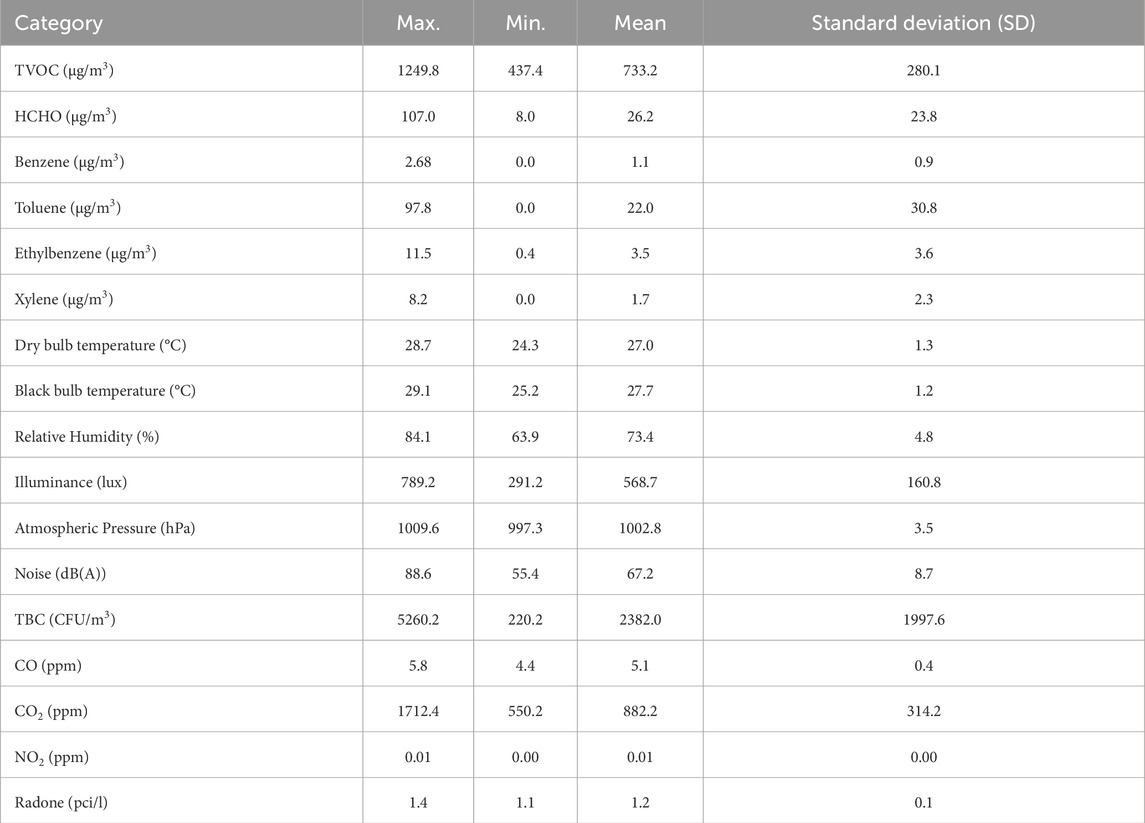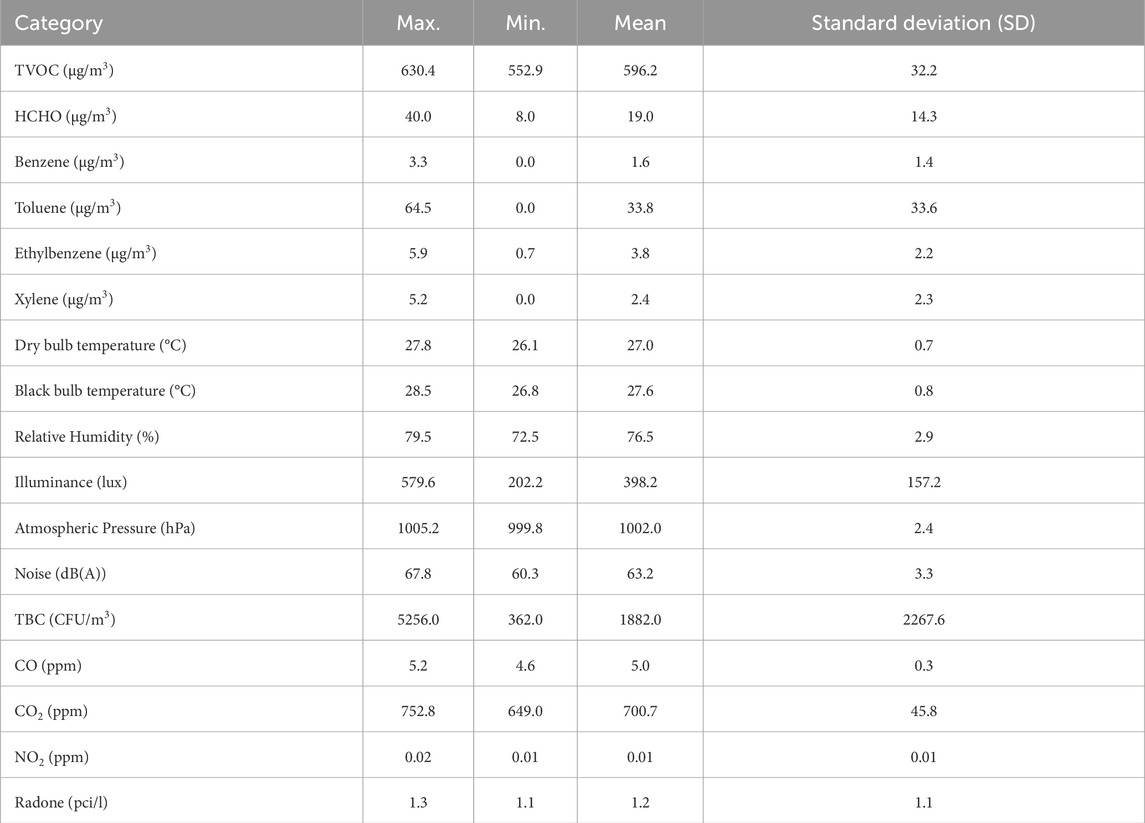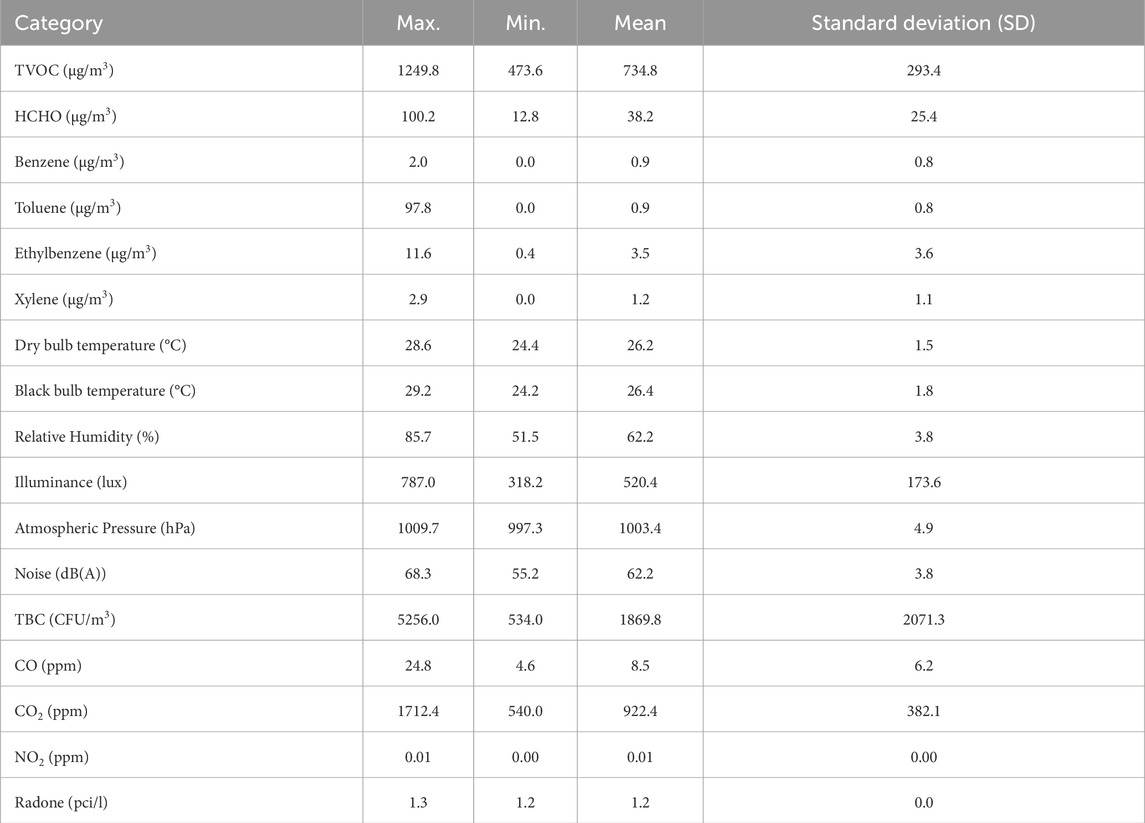- 1Department of Architecture, Prince Mohammad bin Fahd University, Khobar, Saudi Arabia
- 2Department of Interior Design, Ajman University, Ajman, United Arab Emirates
- 3Department of Architecture, Ajman University, Ajman, United Arab Emirates
Indoor Air Quality (IAQ) research in educational institutions is crucial for ensuring the health and wellbeing of students and staff. It also contributes to academic performance, energy efficiency, regulation compliance, and cost savings. This study conducted IAQ assessments in three school buildings in Dubai to address the lack of empirical data on IAQ in educational settings. It compared IAQ standards set by the Dubai Municipality with those established by the WHO. Measurements were taken in classrooms, computer labs, and science labs, revealing that some pollutants exceeded maintenance standards, including TVOC, airborne bacteria, and noise levels. However, formaldehyde and VOCs remained within acceptable limits. Computer labs exhibited higher TVOC levels than classrooms, while science labs had even higher levels. Science labs also had higher concentrations of formaldehyde. VOC concentrations generally met WHO standards, except for elevated levels of Benzene in the science lab. TVOC, formaldehyde, airborne bacteria, CO, CO2, and other substances showed higher levels during class sessions, whereas Benzene, Toluene, Ethylbenzene, Xylene, and NO2 exhibited higher levels when classes were not in session. The study also analyzed IAQ changes over time based on building construction age. Generally, TVOC, formaldehyde (HCHO), and other substances decreased over time. However, even in buildings older than 5 years, TVOC occasionally exceeded WHO standards. These findings emphasize the significance of monitoring and maintaining proper IAQ in educational institutions to create a healthy learning environment. Policymakers, school administrators, and researchers can use these insights to develop effective strategies for enhancing IAQ and safeguarding students’ and staff’s wellbeing and academic success.
1 Introduction
Indoor Air Quality (IAQ) research within educational institutions assumes a critical role due to its multifaceted significance (Mushtaha and Helmy, 2017; Jung and Awad, 2021a; Awad and Jung, 2021; Jung and Al Qassimi, 2022). It prioritizes students’ and staff’s health and wellbeing (Maghrabie et al., 2021; Awad and Jung, 2022). Inadequate IAQ poses detrimental consequences, particularly for vulnerable occupants like children, who exhibit heightened susceptibility to indoor pollutants (Kelly and Fussell, 2019; Jung and El Samanoudy, 2023; Jung et al., 2021a). Consequently, extensive research endeavors play a pivotal role in identifying pollutant sources and associated health risks, thereby facilitating the implementation of effective measures to safeguard the wellbeing of individuals (Becerra et al., 2020; Campagnolo et al., 2017). Secondly, IAQ research significantly contributes to academic performance and productivity (Mohamed et al., 2021; Brink et al., 2021; Jia et al., 2021). Empirical studies have unequivocally established that substandard IAQ engenders symptoms that impede concentration and cognitive function, subsequently impinging upon academic achievements (Majd et al., 2019; Asif et al., 2018). Consequently, dedicated research efforts to enhance IAQ become imperative for cultivating a conducive learning environment (Jung and Awad, 2021b). Thirdly, IAQ research is crucial in optimizing energy efficiency and augmenting building performance (Arar et al., 2022). A direct relationship exists among academic performance, energy efficiency, compliance with standards, and cost savings, as each factor reinforces the others in a well-maintained indoor environment (Makaremi et al., 2024). Improved IAQ through efficient ventilation and filtration enhances student concentration and academic outcomes by reducing symptoms of poor air quality, such as fatigue and respiratory issues (Toyinbo, 2023). When aligned with IAQ standards, energy-efficient systems can lower operational costs by reducing excessive energy usage while ensuring regulatory compliance. Adhering to IAQ standards minimizes potential health-related expenses for schools, resulting in long-term cost savings through fewer student absences, lower maintenance requirements, and optimized resource allocation. This interconnected approach fosters a healthier, more productive, and cost-effective educational environment. Achieving an optimal equilibrium entails meticulous management of ventilation rates, accurate control of pollutant sources, and the strategic implementation of efficient filtration systems, all collectively enhancing IAQ while minimizing energy consumption (Arar and Jung, 2022; Jung et al., 2021b; Jung et al., 2021c). Through research investigations, viable strategies to strike this delicate balance can be discerned, fostering energy conservation and facilitating the development of sustainable school infrastructure (Jung and Awad, 2023; Mahmoud et al., 2023). Additionally, IAQ research is invaluable in ensuring compliance with pertinent legal and regulatory standards (Ndou and Aigbavboa, 2023; Jung and Abdelaziz Mahmoud, 2023). A comprehensive understanding of these requirements proves pivotal in safeguarding the health and wellbeing of occupants while averting potential legal entanglements (Abdelaziz Mahmoud and Jung, 2023). Finally, investments in IAQ research yield substantial long-term cost savings by curbing health-related absences, amplifying productivity levels, and potentially reducing maintenance expenses (Mushtaha et al., 2021; Jung et al., 2022a). Overall, the significance of IAQ research in educational settings is indisputable, as it effectively cultivates healthier and more productive learning environments, benefitting both students and staff (Li and Yu, 2022; Jung and Mahmoud, 2022).
Between 2013 and 2014, the Public Health and Safety Department of Dubai Municipality evaluated IAQ comprehensively in 70 educational institutions, including universities, schools, nurseries, kindergartens, and healthcare centers (Mushtaha et al., 2020; Dubai Municipality, 2023; Al Qassimi and Jung, 2022). This initiative seeks to implement globally recognized benchmarks for the internal environment while ensuring their alignment with the specific local context of Dubai (Jung et al., 2021d; Jung et al., 2022b). The overarching objective is cultivating a healthy cityscape with a pollutant-free atmosphere (Jung and Arar, 2023). The study emphasizes segments of the population most vulnerable to the detrimental effects of substandard IAQ, including children of all ages, individuals with underlying health conditions, and the elderly (Hwang et al., 2018; Kelly and Fussell, 2019; Mushtaha et al., 2022). Motivated by the observations of numerous healthcare organizations, which indicate that indoor pollutant levels can surpass those found outdoors, the initiative acknowledges that a significant portion of people spend up to 90% of their time indoors (Cincinelli and Martellini, 2017; Liu et al., 2020).
The study aims to measure indoor pollution levels, identify sources of contamination, and propose effective strategies aimed at mitigating and reducing the concentration of indoor pollutants (Widder and Haselbach, 2017). This assessment served as the basis for establishing stringent IAQ regulations by Dubai Municipality (Kakoulli et al., 2022). These regulations stipulate that formaldehyde (HCHO) levels should not exceed 0.08 ppm (parts per million), Total Volatile Organic Compound (TVOC) levels should be below 300 μg/m3, and suspended particulates (PM10) should not exceed 150 μg/m3 during continuous monitoring for 8 h before occupancy (Amoatey et al., 2018). Despite these rigorous IAQ standards set for childcare facilities, adherence to these standards is lacking in practice (Vardoulakis et al., 2020). Failure to meet these IAQ standards not only hampers learning efficiency among infants and children but also gives rise to significant symptoms of Sick Building Syndrome (SBS), including respiratory ailments, nausea, eye irritation, drowsiness, and potential long-term health complications (Samudro et al., 2022; Hussien et al., 2023a).
This study presents the empirical findings obtained from an investigation conducted in December 2022, focusing on the indoor environment of three school buildings in Dubai. The study aims to provide crucial measurement data about indoor air pollutants within school premises, explicitly concerning their potential impact on students during their formative years, encompassing infancy and adolescence. By offering tangible measurement data derived from assessments conducted in school buildings, this study fills an existing void in the absence of comprehensive empirical data.
Furthermore, this study aims to delineate the current IAQ standard established by the Dubai Municipality. By furnishing foundational data for subsequent investigations, this study strives to identify the prevailing contamination levels in school environments and undertake a comparative analysis vis-à-vis the IAQ standards promulgated by the World Health Organization (WHO). Such a comparative assessment contributes to a comprehensive understanding of the IAQ landscape while guiding future research endeavors.
2 Materials and methods
Sick Building Syndrome (SBS), primarily from HCHO and VOCs emitted by building materials, has gained significant attention as a research area in the last decade (Ismaeel et al., 2022; Liu et al., 2022; D’Amico et al., 2020). Symptoms associated with SBS include irritation of the eyes, nose, and throat, headaches, fatigue, difficulty concentrating, and occasionally dizziness, nausea, and chest tightness (Teiri et al., 2021; Arar and Jung, 2021). Table 1 provides an overview of the effects of each hazardous substance on the human body (Hussien et al., 2023b).
Table 2 presents WHO’s IAQ standards, outlining their comprehensive regulations (Mikola et al., 2022). These standards not only adhere to the guidelines set by the WHO but also provide detailed specifications based on the duration of exposure (Parkinson et al., 2019; McArthur and Powell, 2020).
2.1 Overview of measurements and analysis conditions
The measurements were conducted over 1 month in January 2023, focusing on three international schools in Dubai that encompassed elementary, middle, and high school levels within a single campus (Zhou and Bai, 2023). A total of 18 rooms, including classrooms, computer labs, and science labs (Figure 1), were selected for measurement at Dubai American Academy, GEMS World Academy Dubai, and GEMS Wellington International School (Figure 2) (DAA, 2023; World Academy, 2023; Wellington International School, 2023). To minimize any potential bias in results across different room types, measurements were conducted under standardized conditions, including similar times of day, consistent sampling durations, and identical equipment settings. Each room type was also sampled multiple times to account for any fluctuations due to occupancy or usage patterns. By using identical measurement protocols and rotating sampling sequences between room types, we aimed to ensure that the unique characteristics of any single room type did not skew results. The objective was to identify and analyze the existing level of contamination within these facilities (Fonseca et al., 2022).
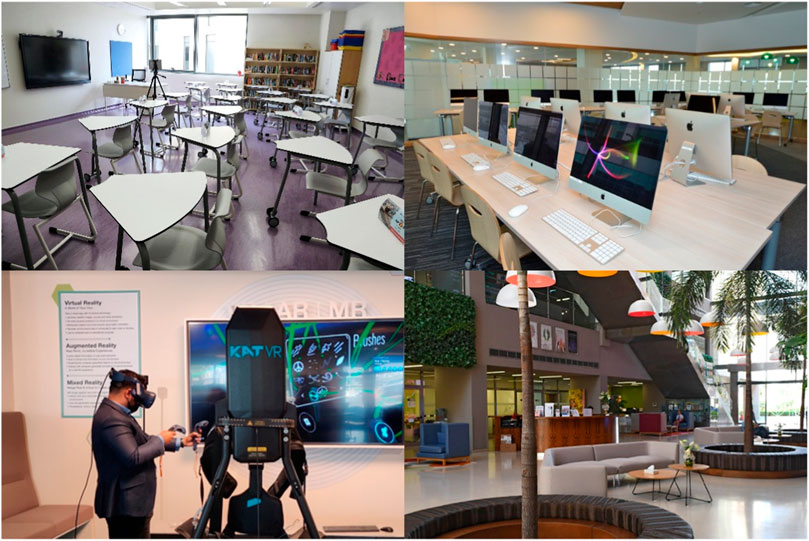
Figure 1. Classroom (top left), computer lab (top right), science lab (bottom left), lobby (bottom right).
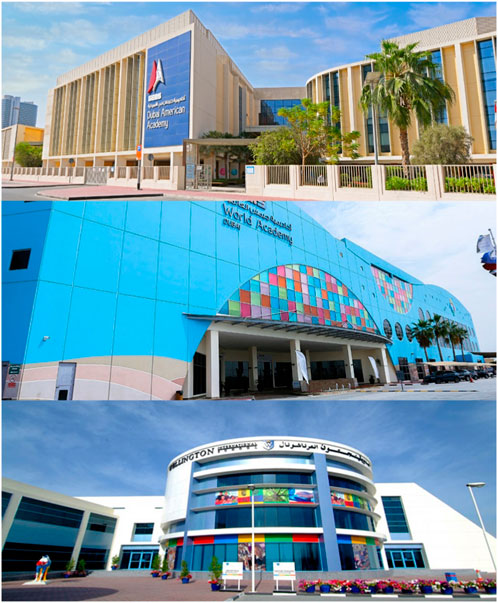
Figure 2. Dubai American academy (top), world academy dubai (middle), wellington international school (bottom).
Since obtaining permission from the school principal was a prerequisite for conducting measurements on school premises, the number of measured schools and classrooms was limited due to the complexities associated with coordinating efforts with the Ministry of Education.
Given the nature of classroom settings, it was not feasible to measure indoor air quality during specific periods, such as class sessions or breaks (Korsavi et al., 2020; Heracleous and Michael, 2019). The WHO Indoor Air Quality Management guidelines carried out the measurements stipulating testing under normal environmental conditions (Hormigos-Jimenez et al., 2019; Agarwal et al., 2021). Table 3 summarizes the three schools in Dubai that were subjected to measurement and analysis.
To comprehensively assess the indoor air quality of the targeted school, the classroom environment was measured using the specific measurement methods and equipment outlined in Table 4 (Vilcekova et al., 2017; Gabriel et al., 2021). For each room type (classroom, computer lab, and science lab), measurements were taken consistently at specific times of the day and for predetermined durations to control for diurnal variations. Equipment calibration was conducted per manufacturer guidelines before each sampling period to ensure accuracy. A gas chromatograph and a mass spectrometer (GC/MS) were used for VOC analysis. High-performance liquid chromatography (HPLC) was employed to analyze formaldehyde (HCHO) concentrations, using a standardized flow rate and sample preparation protocol to maintain consistency across all measurements. Additional details, such as ambient temperature, humidity, and airflow, were recorded concurrently to contextualize pollutant levels (Shen et al., 2021; Kim et al., 2022).
To establish a calibration curve for the volatile organic compounds, a TO-14 standard gas containing each component at a concentration of 100 parts per billion (ppb) was utilized (Kelly and Fussell, 2019). To create a calibration curve for aldehyde analysis, a standard solution necessary for calibration was prepared by diluting a purchased HCHO standard solution (carb carbonyl-DNPHmix, 200 ppm) with an acetonitrile solution. Each standard solution was analyzed using HPLC, and a calibration curve was subsequently generated based on the individual component’s area response.
3 Results
3.1 Measurement results and analysis according to classroom type
The subsequent data represents the average values obtained from comprehensive measurements conducted in December 2022 across 18 classrooms, comprising classrooms, computer labs, and science labs, in three international schools (at Dubai American Academy, GEMS World Academy Dubai, and GEMS Wellington International School).
As illustrated in Table 5, the average measured values indicate that, regarding TVOC, total airborne bacteria, and noise levels, the recorded values surpass the designated maintenance standards. Conversely, for the remaining pollutants, the measured results demonstrate that they are, on average, within the prescribed limits, thus meeting the required standards.
TVOC assessment yielded a maximum recorded value of 1584.0 μg/m3, signifying the highest TVOC concentration observed. Conversely, the minimum recorded value was 437.2 μg/m3, representing the lowest TVOC concentration detected. The average concentration, indicated by the mean value of 780.8 μg/m3, offers an overall representation of TVOC levels across the measured classrooms. The standard deviation (SD) of 306.1 demonstrates the extent of variability in TVOC concentrations.
Findings reveal a maximum recorded value of 135.8 μg/m3 for HCHO concentration, while the minimum is 7.8 μg/m3. The average concentration, denoted by the mean value of 40.0 μg/m3, indicates the typical HCHO levels measured. The standard deviation of 38.2 reflects the extent of variability in HCHO concentrations.
Total Bacterial Count (TBC) assessment yielded a maximum recorded value of 5256.0 CFU/m3, representing the highest count of total airborne bacteria observed. The minimum recorded value is 202.0 CFU/m3, indicating the lowest bacterial count detected. The mean value of 2176.4 CFU/m3 presents an average bacteria count across the measured classrooms. The standard deviation of 1995.8 signifies the variability in TBC measurements.
Results demonstrate a maximum recorded value of 1712.4 ppm for CO2 concentration, while the minimum is 540.2 ppm. The average concentration, represented by the mean value of 811.0 ppm, signifies the typical CO2 levels measured. The standard deviation of 278.8 reflects the degree of variability in CO2 concentrations.
In Figures 3, 4, a comprehensive comparison of measurement results for TVOC and HCHO across different classroom types is presented. Regarding TVOC, it is evident that the measurements conducted in July exceeded the WHO standard of 400 μg/m3 for the entire classroom. The higher TVOC levels observed in computer labs than in classrooms may be attributed to electronic equipment emitting VOCs during regular operation, such as computers and monitors. In addition, these labs often have reduced ventilation due to closed windows and doors, intensifying VOC concentration. Even higher TVOC levels in science labs are likely due to the presence of chemical reagents and lab materials that release a variety of VOCs, combined with less frequent ventilation to control fumes. Both room types demonstrate how specific activities and equipment can increase VOC emissions compared to general classroom environments, which typically involve fewer VOC-emitting sources.
Furthermore, the levels observed in the science lab were approximately 14% higher than those recorded in the classroom, while the computer lab exhibited levels about 70% higher than the classroom. Overall, the concentrations of TVOC surpassed the maintenance standard of 400 μg/m3, whereas the concentrations of HCHO remained within the standard limit of 100 μg/m3. Concerning HCHO, higher levels were detected in the science labs compared to the classrooms and computer labs.
The concentrations of VOCs, including Benzene (Figure 5), Toluene (Figure 6), Ethylbenzene (Figure 7), and Xylene (Figure 8), were found to be significantly lower than the recommended indoor air quality standards set by the WHO. Upon comparing the measured values, it is observed that the concentrations were relatively higher in the computer lab compared to the classroom. Additionally, only Benzene exhibited moderately elevated levels in the science lab.
When considering the total suspended bacteria (TBC), elevated levels were detected across all classroom types, surpassing the standard value of 800 CFU/m3 (Figure 9). Specifically, in the computer lab, the TBC measurement was 84% higher compared to the classroom with a larger student population.
Typically, one would anticipate higher airborne bacteria levels in classrooms with more occupants. However, in the case of computer rooms, it can be inferred that the higher TBC levels result from limited ventilation due to windows and doors being locked and closed outside of operational hours, primarily for security and loss prevention purposes. Additionally, the humid climate in December potentially provides a conducive environment for the proliferation of airborne bacteria.
The measurement results for CO, CO2 (Figure 10), NO2 (Figure 11), and radon (Figure 12) indicate that only the average CO value measured in the computer lab slightly exceeded the WHO standard. At the same time, all other substances remained within the prescribed maintenance limits. The computer room exhibited higher CO, CO2, and NO2 measurements than other classrooms.
3.2 Analysis of measurement results according to class/no class
Tables 6, 7 provide measurement results specifically for classrooms, excluding the computer lab and science lab, among the various classrooms assessed in the three schools under study. TVOC and HCHO measurements exhibited a notable frequency of higher values during class sessions. Conversely, VOC substances such as Benzene, Toluene, Ethylbenzene, and Xylene consistently demonstrated elevated measured values when classes were not in session. Airborne bacteria, CO, CO2, and radon, exhibited higher levels during class sessions, whereas NO2 showed higher levels when classes were not in session.
3.3 Analysis of measurement results according to years after construction
Indoor air pollutants can originate from various sources, including building structures, interior materials, occupants, and external sources. Furniture and construction materials, particularly those containing synthetic resins, adhesives, and chemical finishes, significantly contribute to this study’s VOC levels (Ulker et al., 2021). Over time, these materials release VOCs such as formaldehyde, benzene, toluene, and xylene through a process known as off-gassing. This off-gassing can be prolonged and may intensify with changes in temperature and humidity within the classrooms, thereby influencing pollutant levels during both occupied and unoccupied periods. Additionally, some materials may trap airborne pollutants, which are re-released over time, affecting overall IAQ (Vitaliano et al., 2024). Contaminants generated by the building structure or interior materials are typically emitted in small quantities over an extended period. While the immediate effects may go unnoticed by occupants, these pollutants can adversely impact human health. In newly constructed buildings, indoor air pollutants from building finishing materials are often more prevalent. However, it is generally observed that the concentration of such pollutants gradually decreases over time after construction.
Therefore, this study compares measurement results based on the temporal changes in the target school building. The measurements were taken at various locations students occupy, including classrooms, science rooms, and computer rooms (Tables 8, 9).
The analysis covered 5 years, with one school having less than 5 years of construction (6 classrooms) and two schools having five or more years of construction (12 classrooms). Upon reviewing the measurement results, it was observed that both TVOC, HCHO, and other substances exhibited a decreasing trend, ranging from 18% to 65%. This trend suggests that newer buildings typically have higher VOC emissions due to off gassing from recently installed materials, such as adhesives, paints, and finishes (Halios et al., 2022). Over time, as these materials age and off-gassing rates decrease, IAQ generally improves, resulting in lower concentrations of VOCs and formaldehyde in older buildings. However, even in buildings older than 5 years, the levels of TVOC sometimes exceeded the WHO standard of 400 μg/m³, indicating that factors such as inadequate ventilation or the introduction of new VOC sources (e.g., furniture or renovations) can still impact IAQ regardless of building age.
4 Discussion
The measurement results offer significant insights into the IAQ within the surveyed classrooms of three international schools in Dubai. Specific sources of pollutants identified in this study likely include building materials, furnishings, and electronic equipment, each contributing different types of VOCs and formaldehyde. For example, furniture adhesives and synthetic materials in seating and flooring can emit VOCs continuously, while electronic equipment in computer labs contributes to higher TVOC levels during operational hours. Environmental factors such as ventilation rates, temperature, and humidity also play a crucial role in influencing these pollutant levels, with higher emissions often observed under warmer and more humid conditions or in poorly ventilated spaces. Based on these findings, several strategies can be proposed to improve IAQ in educational settings. Implementing advanced ventilation systems with real-time monitoring, selecting low-emission materials for future renovations, and maintaining consistent temperature and humidity control are essential. Additionally, adopting regular cleaning protocols with low-VOC cleaning agents and scheduling periodic IAQ assessments can further help maintain healthy indoor environments. Future studies focusing on the emission rates of specific materials in controlled environments could further inform these strategies and enhance their effectiveness.
The average values derived from the comprehensive measurements conducted in December 2022 indicate that certain pollutants, including TVOC, total airborne bacteria, and noise levels, surpassed the prescribed maintenance standards. Conversely, the measurements for other pollutants remained within acceptable limits, meeting the requisite standards. The evaluation of TVOC revealed a wide range of concentrations, with the highest recorded value reaching 1584.0 μg/m3, signifying the peak TVOC concentration observed. In contrast, the lowest recorded value was 437.2 μg/m3, representing the minimum TVOC concentration detected. The average concentration, denoted by the mean value of 780.8 μg/m3, provides a comprehensive overview of the TVOC levels across the surveyed classrooms. The standard deviation of 306.1 reflects the extent of variability in TVOC concentrations. Regarding HCHO, the maximum recorded value was 135.8 μg/m3, while the minimum was 7.8 μg/m3. The average concentration, indicated by the mean value of 40.0 μg/m3, represents the typical HCHO levels measured. The standard deviation of 38.2 signifies the extent of variability in HCHO concentrations. Analysis of the TBC revealed a maximum recorded value of 5256.0 CFU/m3, indicating the highest count of total airborne bacteria observed. Conversely, the minimum recorded value amounted to 202.0 CFU/m3, representing the lowest bacterial count detected. The mean value of 2176.4 CFU/m3 presents the average count of bacteria across the surveyed classrooms, while the standard deviation of 1995.8 reflects the variability in TBC measurements. The measurement results for CO2 exhibited a maximum recorded value of 1712.4 ppm, whereas the minimum value recorded was 540.2 ppm. The average concentration, represented by the mean value of 811.0 ppm, signifies the typical CO2 levels measured. The standard deviation of 278.8 indicates the degree of variability in CO2 concentrations.
Comparing the measurement results for TVOC and HCHO across different classroom types, it is evident that TVOC levels surpassed the WHO standard of 400 μg/m3, even in buildings older than 5 years. The science lab demonstrated approximately 14% higher TVOC levels than the classroom, while the computer lab exhibited about 70% higher levels. In contrast, the concentrations of HCHO remained within the standard limit of 100 μg/m3, with higher levels detected in the science labs compared to the classrooms and computer labs. The concentrations of VOCs, such as Benzene, Toluene, Ethylbenzene, and Xylene, were significantly lower than the WHO-recommended IAQ standards. When comparing the measured values, relatively higher concentrations were observed in the computer lab compared to the classroom. Benzene was the only substance exhibiting moderately elevated levels in the science lab. Elevated benzene levels, specifically in the science lab, may be attributed to chemical reagents or lab materials containing benzene, commonly used in certain laboratory activities. Additionally, the restricted ventilation typical in lab settings can lead to localized accumulation, thus exceeding WHO standards.
Analyzing the measurements based on class sessions revealed that TVOC and HCHO measurements exhibited higher values during class sessions. This correlation among TVOC, formaldehyde, airborne bacteria, CO, and CO₂ likely stems from increased occupancy and activity during class hours, which elevate emissions from human respiration, body odors, and materials within the classroom (Nandan et al., 2021). Formaldehyde and TVOC emissions can also increase due to interactions with body heat and friction against classroom surfaces, such as desks and floors. Additionally, limited classroom ventilation may lead to localized accumulation of these substances, further explaining the observed correlation. Conversely, VOC substances like Benzene, Toluene, Ethylbenzene, and Xylene consistently demonstrated elevated measured values when classes were not in session. This pattern suggests that these pollutants may originate from continuous building materials and furnishings emissions (Poirier et al., 2021). Many construction materials, such as adhesives, sealants, synthetic resins, and certain types of paint, are known to release VOCs over extended periods through off-gassing. This process is influenced by factors such as temperature and humidity, which can enhance emissions in closed environments when windows and doors are shut, as is typical during non-class hours. Future research could focus on identifying specific materials responsible for elevated VOC levels and assessing how these emissions vary over time and with environmental conditions. Such studies would offer valuable insights into material-specific contributions to indoor air quality issues and guide the selection of low-emission materials in school environments. The elevated levels of these substances during non-class periods may be attributed to off-gassing from building materials, furnishings, and cleaning products, which continue to release VOCs even in the absence of occupants. Additionally, limited ventilation during non-class hours, as windows and doors are often kept closed, may contribute to the buildup of these substances in the indoor air (Sadrizadeh et al., 2022). NO₂ levels also tend to rise during non-class periods, likely due to reduced ventilation, allowing any residual emissions from outdoor sources or internal equipment to accumulate (Salonen et al., 2019). Airborne bacteria, CO, CO2, and radon levels were higher during class sessions, while NO2 levels were higher when classes were not in session. The observed increase in NO₂ levels during non-class periods likely originates from indoor sources rather than outdoor emissions. Combustion-based equipment, such as gas stoves, heating systems, or laboratory burners, may contribute to these levels. This is consistent with findings that NO₂ emissions from indoor sources can accumulate in poorly ventilated environments when windows and doors are closed. While reduced ventilation during non-class periods may limit the inflow of outdoor NO₂, it can exacerbate the accumulation of NO₂ from indoor sources due to limited air exchange. Further investigation into the presence and use of combustion-based equipment in these spaces is necessary to confirm this hypothesis.
Considering the temporal changes in the target school building, the concentrations of TVOC, HCHO, and other substances generally displayed a decreasing trend ranging from 18% to 65%. However, it is worth noting that even in buildings older than 5 years, the levels of TVOC occasionally exceeded the WHO standard of 400 μg/m3.
These findings offer valuable insights into the IAQ levels in school environments in Dubai. As this study is based on a limited sample of schools within a specific region, the results primarily serve as a case study. They may not fully capture the variability of IAQ across different geographical locations, building designs, or operational practices. Future studies should incorporate a larger, more diverse sample to allow for statistical generalization and support broader conclusions. Comparative studies across different climates, building types, and ventilation systems would provide more robust data on IAQ trends in educational environments. Additionally, longitudinal studies could help determine how IAQ evolves in response to changes in building materials, occupancy patterns, and maintenance practices. By comparing the measurements against established IAQ standards, this study contributes to a comprehensive understanding of the current IAQ landscape and guides future research endeavors. The results emphasize the significance of monitoring and maintaining proper IAQ in schools to ensure a healthy and conducive learning environment for students and teachers. Monitoring and maintaining adequate IAQ in educational institutions is crucial for fostering a healthy learning environment. Poor IAQ can negatively impact students’ health, concentration, and cognitive performance, ultimately affecting academic outcomes. Regular monitoring allows administrators to promptly identify and address IAQ issues, reducing health risks and enhancing comfort for students and staff. Implementing systematic IAQ management practices, including scheduled ventilation checks, use of low-emission materials, and periodic air quality assessments, can help ensure that educational spaces remain safe, conducive to learning, and aligned with health standards. By prioritizing IAQ, educational institutions can contribute to students’ wellbeing and academic success.
5 Conclusion
A total of 18 classrooms were measured in three international schools during winter in Dubai in December 2022. The measurement results were analyzed based on overall averages, classroom types, class presence, and the secular change of the school buildings. The summary of the measurement results is as follows:
The average air quality measurements across all classrooms revealed that TVOC and airborne bacteria exceeded the standards set by the WHO. While these findings are significant for understanding IAQ in Dubai’s educational institutions, they are limited by the study’s scope as a case study. Broader, multi-regional studies are necessary to confirm whether the observed IAQ patterns hold in diverse educational settings and climates. Such expanded research could enhance these conclusions’ applicability, offering generalizable policy insights across various contexts. Additionally, noise levels surpassed the recommended limits. Other contaminants, besides TVOC and HCHO, were detected at lower levels that did not meet the maintenance standards. However, in the science or computer labs, these contaminants were measured at least 15% and up to 70% higher than in general classrooms.
When comparing the measurement results during class and non-class periods for general classrooms (excluding science labs and computer labs), it was found that TVOC, HCHO, airborne bacteria (TBC), CO, CO2, and other substances showed higher measured values during class sessions. On the other hand, Benzene, Toluene, Ethylbenzene, Xylene, and NO2 exhibited higher measured values when classes were not in session.
Notably, TVOC levels were generally higher during class sessions, while Benzene, Toluene, Ethylbenzene, Xylene, and other substances exhibited higher average measurement values during non-class periods. This contrasts with the expectation that substances like Benzene and Toluene, which are components of TVOC, would also show higher levels during class sessions. It can be inferred that undetected VOCs other than Ethylbenzene and Xylene are relatively high during classes with more students.
These results suggest that pollutants from general organic chemical products, such as student clothing or school supplies, may contribute to the observed levels. Further investigation and analysis of various substances among TVOC components in future studies would provide valuable insights.
Benzene and Toluene, commonly found in building materials, may contribute to the higher levels detected during non-class periods. The increased amount of pollutants leaked from classroom building materials could be attributed to the closure of doors and external windows during non-class periods.
Comparing the pollutant measurements based on the secular changes in schools constructed less than 5 years ago and schools built more than 5 years ago, it was observed that TVOC, HCHO, Benzene, Toluene, Ethylbenzene, and Xylene displayed a tendency to decrease by an average of 18%–65% in schools older than 5 years.
It is important to note that the measurements were conducted during Dubai’s winter, which was characterized by high classroom temperatures and humidity. The results should be considered in light of the natural ventilation occurring through the opening and closing doors and windows.
The measurements of TVOC and airborne bacteria, encompassing various volatile organic compounds, exceeded the legally recommended standards and maintenance standards for indoor air quality management as outlined by the WHO.
These results indicate that despite the significant natural ventilation mentioned earlier, the indoor air quality in the measured schools during December did not maintain a favorable environment.
To enhance indoor air quality (IAQ) in educational institutions, policymakers and school administrators should focus on several key strategies. Improving ventilation systems is essential, especially in science and computer labs with elevated VOC levels. Advanced filtration and ventilation enhancements can help control pollutant levels during occupied and unoccupied hours. Regular IAQ monitoring and transparent reporting can enable prompt responses to air quality concerns, helping maintain healthy environments aligned with WHO and local standards. Prioritizing low-emission building materials and furniture, especially during renovations, will mitigate long-term VOC emissions and improve overall IAQ. Additionally, using low-emission cleaning agents and scheduling cleaning during non-peak occupancy hours can further prevent pollutant accumulation. Awareness and training programs for staff and students can foster proactive IAQ management behaviors, reinforcing a commitment to health and safety. These recommendations provide practical steps for creating healthier and more conducive learning environments that support wellbeing and academic success.
Moreover, the varying composition ratios of indoor pollutants in different classrooms within the same school, such as science labs and computer labs, indicate the need for different ventilation standards for these specialized classrooms. Further investigation is warranted to study the emission characteristics of other individual volatile organic compounds included in TVOC, apart from Ethylbenzene and Xylene, by analyzing pollutants during class and non-class periods. Specific ventilation standards should be considered for general and special-purpose classrooms like science and computer labs.
Data availability statement
The raw data supporting the conclusions of this article will be made available by the authors, without undue reservation.
Author contributions
CJ: Conceptualization, Investigation, Methodology, Project administration, Supervision, Writing–original draft. GE: Data curation, Formal Analysis, Methodology, Resources, Software, Validation, Visualization, Writing–review and editing. NA: Data curation, Formal Analysis, Project administration, Resources, Software, Writing–review and editing.
Funding
The author(s) declare that no financial support was received for the research, authorship, and/or publication of this article.
Acknowledgments
The authors would like to thank Prince Mohammad bin Fahd and Ajman University for their support for APC and for providing a great research environment.
Conflict of interest
The authors declare that the research was conducted in the absence of any commercial or financial relationships that could be construed as a potential conflict of interest.
Publisher’s note
All claims expressed in this article are solely those of the authors and do not necessarily represent those of their affiliated organizations, or those of the publisher, the editors and the reviewers. Any product that may be evaluated in this article, or claim that may be made by its manufacturer, is not guaranteed or endorsed by the publisher.
References
Abdelaziz Mahmoud, N. S., and Jung, C. (2023). Analyzing the bake-out effect in winter for the enhancement of indoor air quality at new apartments in UAE. Buildings 13 (4), 846. doi:10.3390/buildings13040846
Agarwal, N., Meena, C. S., Raj, B. P., Saini, L., Kumar, A., Gopalakrishnan, N., et al. (2021). Indoor air quality improvement in COVID-19 pandemic: review. Sustain. Cities Soc. 70, 102942. doi:10.1016/j.scs.2021.102942
Al Qassimi, N., and Jung, C. (2022). Impact of air-purifying plants on the reduction of volatile organic compounds in the indoor hot desert climate. Front. Built Environ. 7, 188. doi:10.3389/fbuil.2021.803516
Amoatey, P., Omidvarborna, H., Baawain, M. S., and Al-Mamun, A. (2018). Indoor air pollution and exposure assessment of the gulf cooperation council countries: a critical review. Environ. Int. 121, 491–506. doi:10.1016/j.envint.2018.09.043
Arar, M., and Jung, C. (2021). Improving the indoor air quality in nursery buildings in United Arab Emirates. Int. J. Environ. Res. Public Health 18 (22), 12091. doi:10.3390/ijerph182212091
Arar, M., and Jung, C. (2022). Analyzing the perception of indoor air quality (IAQ) from a survey of new townhouse residents in Dubai. Sustainability 14 (22), 15042. doi:10.3390/su142215042
Arar, M., Jung, C., and Qassimi, N. A. (2022). Investigating the influence of the building material on the indoor air quality in apartment in Dubai. Front. Built Environ. 7, 804216. doi:10.3389/fbuil.2021.804216
Asif, A., Zeeshan, M., and Jahanzaib, M. (2018). Indoor temperature, relative humidity and CO2 levels assessment in academic buildings with different heating, ventilation and air-conditioning systems. Build. Environ. 133, 83–90. doi:10.1016/j.buildenv.2018.01.042
Awad, J., and Jung, C. (2021). Evaluating the indoor air quality after renovation at the Greens in Dubai, United Arab Emirates. Buildings 11 (8), 353. doi:10.3390/buildings11080353
Awad, J., and Jung, C. (2022). Extracting the planning elements for sustainable urban regeneration in Dubai with AHP (analytic hierarchy process). Sustain. Cities Soc. 76, 103496. doi:10.1016/j.scs.2021.103496
Becerra, J. A., Lizana, J., Gil, M., Barrios-Padura, A., Blondeau, P., and Chacartegui, R. (2020). Identification of potential indoor air pollutants in schools. J. Clean. Prod. 242, 118420. doi:10.1016/j.jclepro.2019.118420
Brink, H. W., Loomans, M. G., Mobach, M. P., and Kort, H. S. (2021). Classrooms' indoor environmental conditions affecting the academic achievement of students and teachers in higher education: a systematic literature review. Indoor air 31 (2), 405–425. doi:10.1111/ina.12745
Campagnolo, D., Saraga, D. E., Cattaneo, A., Spinazzè, A., Mandin, C., Mabilia, R., et al. (2017). VOCs and aldehydes source identification in European office buildings-The OFFICAIR study. Build. Environ. 115, 18–24. doi:10.1016/j.buildenv.2017.01.009
Cincinelli, A., and Martellini, T. (2017). Indoor air quality and health. Int. J. Environ. Res. public health 14 (11), 1286. doi:10.3390/ijerph14111286
DAA (2023). Outstanding American school in Dubai - GEMS Dubai. Available at: https://www.gemsaa-dubai.com/.
D’Amico, A., Pini, A., Zazzini, S., D’Alessandro, D., Leuzzi, G., and Currà, E. (2020). Modelling VOC emissions from building materials for healthy building design. Sustainability 13 (1), 184. doi:10.3390/su13010184
Dubai Municipality (2023). Green building regulations and specifications. Available at: https://www.dm.gov.ae/wp-ontent/uploads/2020/11/GreenBuildingRegulationsandSpeci-2.pdf.
Fonseca, A., Abreu, I., Guerreiro, M. J., and Barros, N. (2022). Indoor air quality in healthcare units—a systematic literature review focusing recent research. Sustainability 14 (2), 967. doi:10.3390/su14020967
Gabriel, M. F., Paciencia, I., Felgueiras, F., Rufo, J. C., Mendes, F. C., Farraia, M., et al. (2021). Environmental quality in primary schools and related health effects in children. An overview of assessments conducted in the Northern Portugal. Energy Build. 250, 111305. doi:10.1016/j.enbuild.2021.111305
Halios, C. H., Landeg-Cox, C., Lowther, S. D., Middleton, A., Marczylo, T., and Dimitroulopoulou, S. (2022). Chemicals in European residences–Part I: a review of emissions, concentrations and health effects of volatile organic compounds (VOCs). Sci. Total Environ. 839, 156201. doi:10.1016/j.scitotenv.2022.156201
Heracleous, C., and Michael, A. (2019). Experimental assessment of the impact of natural ventilation on indoor air quality and thermal comfort conditions of educational buildings in the Eastern Mediterranean region during the heating period. J. Build. Eng. 26, 100917. doi:10.1016/j.jobe.2019.100917
Hormigos-Jimenez, S., Padilla-Marcos, M. Á., Meiss, A., Gonzalez-Lezcano, R. A., and Feijó-Muñoz, J. (2019). Assessment of the ventilation efficiency in the breathing zone during sleep through computational fluid dynamics techniques. J. Build. Phys. 42 (4), 458–483. doi:10.1177/1744259118771314
Hussien, A., Jannat, N., Mushtaha, E., and Al-Shammaa, A. (2023b). A holistic plan of flat roof to green-roof conversion: towards a sustainable built environment. Ecol. Eng. 190, 106925. doi:10.1016/j.ecoleng.2023.106925
Hussien, A., Saleem, A. A., Mushtaha, E., Jannat, N., Al-Shammaa, A., Ali, S. B., et al. (2023a). A statistical analysis of life cycle assessment for buildings and buildings’ refurbishment research. Ain Shams Eng. J. 14, 102143. doi:10.1016/j.asej.2023.102143
Hwang, S. H., Roh, J., and Park, W. M. (2018). Evaluation of PM10, CO2, airborne bacteria, TVOCs, and formaldehyde in facilities for susceptible populations in South Korea. Environ. Pollut. 242, 700–708. doi:10.1016/j.envpol.2018.07.013
Ismaeel, W. S., Alamoudy, F. O., and Sameh, R. (2022). How renovation activities may jeopardise indoor air quality: accounting for short and long-term symptoms of sick building syndrome in educational buildings. Archit. Eng. Des. Manag. 19, 360–377. doi:10.1080/17452007.2022.2060932
Jia, L. R., Han, J., Chen, X., Li, Q. Y., Lee, C. C., and Fung, Y. H. (2021). Interaction between thermal comfort, indoor air quality and ventilation energy consumption of educational buildings: a comprehensive review. Buildings 11 (12), 591. doi:10.3390/buildings11120591
Jung, C., and Abdelaziz Mahmoud, N. S. (2023). Exploring customer behavior in shopping malls: a study of rest areas in Dubai, United Arab Emirates. Sustainability 15 (12), 9169. doi:10.3390/su15129169
Jung, C., and Al Qassimi, N. (2022). Investigating the emission of hazardous chemical substances from mashrabiya used for indoor air quality in hot desert climate. Sustainability 14 (5), 2842. doi:10.3390/su14052842
Jung, C., Al Qassimi, N., Abdelaziz Mahmoud, N. S., and Lee, S. Y. (2022a). Analyzing the housing consumer preferences via analytic hierarchy process (AHP) in Dubai, United Arab Emirates. Behav. Sci. 12 (9), 327. doi:10.3390/bs12090327
Jung, C., Al Qassimi, N., Arar, M., and Awad, J. (2021c). The analysis of indoor air pollutants from finishing material of new apartments at business bay, Dubai. Front. Built Environ. 7, 765689. doi:10.3389/fbuil.2021.765689
Jung, C., Alqassimi, N., and El Samanoudy, G. (2022b). Evaluating the adsorption performance of functional building material with HCHO remover. Front. Built Environ. 179. doi:10.3389/fbuil.2022.998872
Jung, C., and Arar, M. (2023). Natural vs. Artificial light: a study on the influence of light source on chlorophyll content and photosynthetic rates on indoor plants. Buildings 13 (6), 1482. doi:10.3390/buildings13061482
Jung, C., and Awad, J. (2021a). The improvement of indoor air quality in residential buildings in Dubai, UAE. Buildings 11 (6), 250. doi:10.3390/buildings11060250
Jung, C., and Awad, J. (2021b). Improving the IAQ for learning efficiency with indoor plants in university classrooms in Ajman, United Arab Emirates. Buildings 11 (7), 289. doi:10.3390/buildings11070289
Jung, C., and Awad, J. (2023). Sharjah sustainable city: an analytic hierarchy process approach to urban planning priorities. Sustainability 15 (10), 8217. doi:10.3390/su15108217
Jung, C., Awad, J., and Al Qassimi, N. (2021d). Evaluation of residents’ comfort in high-rise residential buildings in Dubai, United Arab Emirates. Front. Built Environ. 145. doi:10.3389/fbuil.2021.766057
Jung, C., Awad, J., and Chohan, A. (2021b). The planning of smart elderly housing in Dubai with IoT technologies. Open House Int. 46, 668–681. doi:10.1108/ohi-08-2020-0121
Jung, C., Awad, J., Sami Abdelaziz Mahmoud, N., and Salameh, M. (2021a). An analysis of indoor environment evaluation for the Springs development in Dubai, UAE. Open House Int. 46 (4), 651–667. doi:10.1108/ohi-11-2020-0165
Jung, C., and El Samanoudy, G. (2023). Mitigating indoor air pollution in university dormitory: the need for better ventilation and resident awareness. Buildings 13 (5), 1144. doi:10.3390/buildings13051144
Jung, C., and Mahmoud, N. S. A. (2022). Extracting the critical points of formaldehyde (HCHO) emission model in hot desert climate. Air, Soil Water Res. 15, 11786221221105082. doi:10.1177/11786221221105082
Kakoulli, C., Kyriacou, A., and Michaelides, M. P. (2022). A review of field measurement studies on thermal comfort, indoor air quality and virus risk. Atmosphere 13 (2), 191. doi:10.3390/atmos13020191
Kelly, F. J., and Fussell, J. C. (2019). Improving indoor air quality, health and performance within environments where people live, travel, learn and work. Atmos. Environ. 200, 90–109. doi:10.1016/j.atmosenv.2018.11.058
Kim, Y. K., Abdou, Y., Abdou, A., and Altan, H. (2022). Indoor environmental quality assessment and occupant satisfaction: a post-occupancy evaluation of a UAE University Office Building. Buildings 12 (7), 986. doi:10.3390/buildings12070986
Korsavi, S. S., Montazami, A., and Mumovic, D. (2020). Indoor air quality (IAQ) in naturally-ventilated primary schools in the UK: occupant-related factors. Build. Environ. 180, 106992. doi:10.1016/j.buildenv.2020.106992
Li, M., and Yu, Z. (2022). Teachers’ satisfaction, role, and digital literacy during the COVID-19 pandemic. Sustainability 14 (3), 1121. doi:10.3390/su14031121
Liu, F., Yan, L., Meng, X., and Zhang, C. (2022). A review on indoor green plants employed to improve indoor environment. J. Build. Eng. 53, 104542. doi:10.1016/j.jobe.2022.104542
Liu, S., Cao, Q., Zhao, X., Lu, Z., Deng, Z., Dong, J., et al. (2020). Improving indoor air quality and thermal comfort in residential kitchens with a new ventilation system. Build. Environ. 180, 107016. doi:10.1016/j.buildenv.2020.107016
Maghrabie, H. M., Abdelkareem, M. A., Al-Alami, A. H., Ramadan, M., Mushtaha, E., Wilberforce, T., et al. (2021). State-of-the-art technologies for building-integrated photovoltaic systems. Buildings 11 (9), 383. doi:10.3390/buildings11090383
Mahmoud, N. S. A., Jung, C., and Al Qassimi, N. (2023). Evaluating the aircraft noise level and acoustic performance of the buildings in the vicinity of Dubai International Airport. Ain Shams Eng. J. 14 (8), 102032. doi:10.1016/j.asej.2022.102032
Majd, E., McCormack, M., Davis, M., Curriero, F., Berman, J., Connolly, F., et al. (2019). Indoor air quality in inner-city schools and its associations with building characteristics and environmental factors. Environ. Res. 170, 83–91. doi:10.1016/j.envres.2018.12.012
Makaremi, N., Yildirim, S., Morgan, G. T., Touchie, M. F., Jakubiec, A., and Robinson, J. (2024). Impact of classroom environment on student wellbeing in higher education: review and future directions. Build. Environ. 265, 111958. doi:10.1016/j.buildenv.2024.111958
McArthur, J. J., and Powell, C. (2020). Health and wellness in commercial buildings: systematic review of sustainable building rating systems and alignment with contemporary research. Build. Environ. 171, 106635. doi:10.1016/j.buildenv.2019.106635
Mikola, A., Hamburg, A., Kuusk, K., Kalamees, T., Voll, H., and Kurnitski, J. (2022). The impact of the technical requirements of the renovation grant on the ventilation and indoor air quality in apartment buildings. Build. Environ. 210, 108698. doi:10.1016/j.buildenv.2021.108698
Mohamed, S., Rodrigues, L., Omer, S., and Calautit, J. (2021). Overheating and indoor air quality in primary schools in the UK. Energy Build. 250, 111291. doi:10.1016/j.enbuild.2021.111291
Mushtaha, E., Alsyouf, I., Al Labadi, L., Hamad, R., Khatib, N., and Al Mutawa, M. (2020). Application of AHP and a mathematical index to estimate livability in tourist districts: the case of Al Qasba in Sharjah. Front. Archit. Res. 9 (4), 872–889. doi:10.1016/j.foar.2020.04.001
Mushtaha, E., Dabous, S. A., Alsyouf, I., Ahmed, A., and Abdraboh, N. R. (2022). The challenges and opportunities of online learning and teaching at engineering and theoretical colleges during the pandemic. Ain Shams Eng. J. 13 (6), 101770. doi:10.1016/j.asej.2022.101770
Mushtaha, E., and Helmy, O. (2017). Impact of building forms on thermal performance and thermal comfort conditions in religious buildings in hot climates: a case study in Sharjah city. Int. J. Sustain. Energy 36 (10), 926–944. doi:10.1080/14786451.2015.1127234
Mushtaha, E., Shareef, S., Alsyouf, I., Mori, T., Kayed, A., Abdelrahim, M., et al. (2021). A study of the impact of major Urban Heat Island factors in a hot climate courtyard: the case of the University of Sharjah, UAE. Sustain. Cities Soc. 69, 102844. doi:10.1016/j.scs.2021.102844
Nandan, A., Siddiqui, N. A., Singh, C., and Aeri, A. (2021). Occupational and environmental impacts of indoor air pollutant for different occupancy: a review. Toxicol. Environ. Health Sci. 13 (4), 303–322. doi:10.1007/s13530-021-00102-9
Ndou, M., and Aigbavboa, C. (2023). Exploring environmental policy adoption enablers for indoor air quality management in higher educational institutions in South Africa. Front. Built Environ. 9, 1124248. doi:10.3389/fbuil.2023.1124248
Parkinson, T., Parkinson, A., and de Dear, R. (2019). Continuous IEQ monitoring system: performance specifications and thermal comfort classification. Build. Environ. 149, 241–252. doi:10.1016/j.buildenv.2018.12.016
Poirier, B., Guyot, G., Geoffroy, H., Woloszyn, M., Ondarts, M., and Gonze, E. (2021). Pollutants emission scenarios for residential ventilation performance assessment. A review. J. Build. Eng. 42, 102488. doi:10.1016/j.jobe.2021.102488
Sadrizadeh, S., Yao, R., Yuan, F., Awbi, H., Bahnfleth, W., Bi, Y., et al. (2022). Indoor air quality and health in schools: a critical review for developing the roadmap for the future school environment. J. Build. Eng. 57, 104908. doi:10.1016/j.jobe.2022.104908
Salonen, H., Salthammer, T., and Morawska, L. (2019). Human exposure to NO2 in school and office indoor environments. Environ. Int. 130, 104887. doi:10.1016/j.envint.2019.05.081
Samudro, H., Samudro, G., and Mangkoedihardjo, S. (2022). Prevention of indoor air pollution through design and construction certification: a review of the sick building syndrome conditions. J. Air Pollut. Health 7 (1), 81–94. doi:10.18502/japh.v7i1.8922
Shen, Z., Yang, X., Liu, C., and Li, J. (2021). Assessment of indoor environmental quality in budget hotels using text-mining method: case study of top five brands in China. Sustainability 13 (8), 4490. doi:10.3390/su13084490
Teiri, H., Hajizadeh, Y., and Azhdarpoor, A. (2021). A review of different phytoremediation methods and critical factors for purification of common indoor air pollutants: an approach with sensitive analysis. Air Qual. Atmos. & Health 15, 373–391. doi:10.1007/s11869-021-01118-3
Toyinbo, O. (2023). Indoor environmental quality, pupils’ health, and academic performance—a literature review. Buildings 13 (9), 2172. doi:10.3390/buildings13092172
Ulker, O. C., Ulker, O., and Hiziroglu, S. (2021). Volatile organic compounds (VOCs) emitted from coated furniture units. Coatings 11 (7), 806. doi:10.3390/coatings11070806
Vardoulakis, S., Giagloglou, E., Steinle, S., Davis, A., Sleeuwenhoek, A., Galea, K. S., et al. (2020). Indoor exposure to selected air pollutants in the home environment: a systematic review. Int. J. Environ. Res. public health 17 (23), 8972. doi:10.3390/ijerph17238972
Vilcekova, S., Meciarova, L., Burdova, E. K., Katunska, J., Kosicanova, D., and Doroudiani, S. (2017). Indoor environmental quality of classrooms and occupants' comfort in a special education school in Slovak Republic. Build. Environ. 120, 29–40. doi:10.1016/j.buildenv.2017.05.001
Vitaliano, S., Cascone, S., and D’Urso, P. R. (2024). Mitigating built environment air pollution by green systems: an in-depth review. Appl. Sci. 14 (15), 6487. doi:10.3390/app14156487
Wellington International School (2023). GEMS Wellington international school: an outstanding British curriculum and IB school. Dubai. Available at: https://www.wellingtoninternationalschool.com/.
Widder, S. H., and Haselbach, L. (2017). Relationship among concentrations of indoor air contaminants, their sources, and different mitigation strategies on indoor air quality. Sustainability 9 (7), 1149. doi:10.3390/su9071149
World Academy (2023). GEMS World Academy: leading IB+ school in Dubai. Available at: https://www.gemsworldacademy-dubai.com/en/.
Zhou, H., and Bai, X. (2023). A review of the role of the school spatial environment in promoting the visual health of minors. Int. J. Environ. Res. Public Health 20 (2), 1006. doi:10.3390/ijerph20021006
Nomenclature
IAQ Indoor Air Quality
TVOC Total Volatile Organic Compounds
VOC Volatile Organic Compounds
HCHO Formaldehyde (Chemical formula: CH₂O)
CO Carbon Monoxide
CO₂ Carbon Dioxide
NO₂ Nitrogen Dioxide
PM10 Particulate Matter with a diameter of 10 μm or less
TBC Total Bacterial Count
CFU/m³ Colony-Forming Units per Cubic Meter (measure of airborne bacteria)
dB(A) Decibels (A-weighted), a unit of sound level measurement
μg/m³ Micrograms per Cubic Meter (common unit for pollutant concentration)
ppm Parts Per Million (used to measure gas concentrations)
WHO World Health Organization
CFD Computational Fluid Dynamics
SD Standard Deviation
UAE United Arab Emirates
SBS Sick Building Syndrome
Keywords: indoor air quality (IAQ), educational institutions, formaldehyde (HCHO), total volatile organic compound (TVOC), Dubai, students well-being
Citation: Jung C, El Samanoudy G and Alqassimi N (2024) Indoor air quality in educational institutions: a comparative study of VOCs and bacterial contaminants in Dubai schools. Front. Built Environ. 10:1478681. doi: 10.3389/fbuil.2024.1478681
Received: 10 August 2024; Accepted: 02 December 2024;
Published: 16 December 2024.
Edited by:
Obuks Ejohwomu, The University of Manchester, United KingdomReviewed by:
Hua Qian, Southeast University, ChinaRoberto Alonso González-Lezcano, CEU San Pablo University, Spain
Copyright © 2024 Jung, El Samanoudy and Alqassimi. This is an open-access article distributed under the terms of the Creative Commons Attribution License (CC BY). The use, distribution or reproduction in other forums is permitted, provided the original author(s) and the copyright owner(s) are credited and that the original publication in this journal is cited, in accordance with accepted academic practice. No use, distribution or reproduction is permitted which does not comply with these terms.
*Correspondence: Gamal El Samanoudy, Zy5lbHNhbWFub3VkeUBham1hbi5hYy5hZQ==
 Chuloh Jung
Chuloh Jung Gamal El Samanoudy
Gamal El Samanoudy Nahla Alqassimi
Nahla Alqassimi